Assessment of Distribution Network Hosting Capacity Incorporating Multiple Uncertainty Factors
Abstract
1. Introduction
2. Stochastic Scenario Simulation Method for Distribution Network Hosting Capacity
3. Distribution Network Hosting Capacity Assessment Method Based on Multi-Dimensional Risk Quantification
3.1. Construction of Distribution Network Hosting Capacity Assessment Indicator System Based on Risk Quantification
3.2. Integrated Distribution Network Hosting Capacity Assessment Method with Multi-Dimensional Risk Quantification Indicators
4. Case Studies
4.1. Parameter Settings
4.2. Analysis of Distribution Network Hosting Capacity Assessment Results
- Impact of Source-Load Power Uncertainty on System Risk
- 2.
- Differential Impact of Stochastic Scenario Configuration on System Risk
- 3.
- Multi-Dimensional Risk Quantification of Distribution Systems at Different Penetration Levels
5. Conclusions
- The proposed risk indicators effectively quantify security risks (voltage limit violations, line overloads, and transformer overloads) as well as economic and reliability risks (network losses and loss of load) arising from uncertainties in source-load power and DG configuration schemes. These indicators accurately capture the actual hosting capacity of distribution networks under multiple uncertainties, offering a more scientific basis for decision-making in planning DG integration capacity for new distribution systems with high penetration of DG and EV integration.
- Computational analysis of the multi-dimensional distribution network hosting capacity via the combined weighting method indicates that the optimal hosting capacity considering security risks alone is 3.715 MW, whereas that considering comprehensive risks is 3.9 MW. Under the constraint of an acceptable risk threshold, the maximum hosting capacity attains 5.201 MW. Compared with the optimal capacity of 3.9 MW, this corresponds to a 33.36% increase in hosting capacity under acceptable risk levels. Compared with deterministic hosting capacity evaluation, the proposed stochastic risk-based method significantly improves hosting capacity prediction accuracy and reduces the overall system risk. It can effectively provide more reasonable decision-making guidance for the evaluation of distribution network carrying capacity under the background of considering multiple uncertain factors.
Author Contributions
Funding
Data Availability Statement
Acknowledgments
Conflicts of Interest
References
- Liu, H.; Cao, R.Z.; Han, J.; Cai, C.; Pan, W.J.; Li, J.K. Research Status and Prospect of Distributed Generation Hosting Capacity Evaluation for Distribution Networks. Autom. Electr. Power Syst. 2025, 49, 21–33. [Google Scholar]
- Chen, X.; Wu, W.; Zhang, B. Robust Capacity Assessment of Distributed Generation in Unbalanced Distribution Networks Incorporating ANM Techniques. IEEE Trans. Sustain. Energy 2018, 9, 651–663. [Google Scholar] [CrossRef]
- Wu, S.; Yu, J.; Yang, W. Chance-Constrained Evaluation Model and Transformation Method for Maximum Grid Integration Capacity of Distributed Generation in Distribution Networks. Power Syst. Technol. 2018, 2, 3691–3697. [Google Scholar]
- Mahdavi, M.; Awaafo, A.; Schmitt, K.; Chamana, M.; Jurado, F.; Bayne, S. An Effective Formulation for Minimizing Distribution Network Costs Through Distributed Generation Allocation in Systems With Variable Loads. IEEE Trans. Ind. Appl. 2024, 60, 5671–5680. [Google Scholar] [CrossRef]
- Mahdavi, M.; Jurado, F.; Schmitt, K.; Chamana, M. Electricity Generation From Cow Manure Compared to Wind and Photovoltaic Electric Power Considering Load Uncertainty and Renewable Generation Variability. IEEE Trans. Ind. Appl. 2024, 60, 3543–3553. [Google Scholar] [CrossRef]
- Li, Q.; Deng, Q.; Lin, H. Evaluation and Enhancement Strategy for Electric Vehicle Hosting Capacity in Distribution Systems Considering Flexibility. J. Electr. Power Sci. Technol. 2019, 34, 37–46. [Google Scholar]
- Deng, M.L.; Chen, Y.J.; Bai, Z.Y. Quantitative Method for Distributed Photovoltaic Hosting Capacity of Distribution Networks Based on Static Voltage Stability Margin. J. Shanghai Jiao Tong Univ. 2025, 1–25. [Google Scholar] [CrossRef]
- Dubey, A.; Santoso, S. On Estimation and Sensitivity Analysis of Distribution Circuit’s Photovoltaic Hosting Capacity. IEEE Trans. Power Syst. 2017, 32, 2779–2789. [Google Scholar] [CrossRef]
- Wang, H.; Wang, Z.; Han, H.; Ji, R. Research on Photovoltaic Hosting Capacity of Residential Distribution Networks Using Monte Carlo Hourly Estimation Model. J. Northeast Electr. Power Univ. 2023, 43, 9–19. [Google Scholar]
- Li, Z.; Wang, Y.; Huang, J. Data-Driven Probabilistic Assessment of Distributed Generation Allocation Considering Multi-Source Uncertainty. IEEE Trans. Ind. Appl. 2024, 60, 5123–5135. [Google Scholar]
- Zhang, X.; Chen, L.; Deng, Y. Robust Stochastic Programming for Hosting Capacity Quantification under Correlated Renewable Fluctuations. IEEE Trans. Ind. Appl. 2023, 59, 6891–6902. [Google Scholar]
- Chen, X.; Tian, G.; Zhao, J. Multi-Level Cooperative Evaluation of Renewable Energy Hosting Capacity in Distribution Networks. J. Yanshan Univ. 2025, 49, 121–129. [Google Scholar]
- Ding, F.; Mather, B. On Distributed PV Hosting Capacity Estimation, Sensitivity Study and Improvement. IEEE Trans. Sustain. Energy 2017, 8, 1010–1020. [Google Scholar] [CrossRef]
- Abad, M.S.S.; Ma, J.; Zhang, D.; Ahmadyar, A.S.; Marzooghi, H. Probabilistic Assessment of Hosting Capacity in Radial Distribution Systems. IEEE Trans. Sustain. Energy 2018, 9, 1935–1947. [Google Scholar] [CrossRef]
- Yao, H.; Qin, W.; Jing, X. Assessment Method for Distributed Photovoltaic Hosting Capacity in Low-Voltage Distribution Networks Based on Possibility Theory. High Volt. Eng. 2024, 50, 2682–2692. [Google Scholar]
- Agajie, T.F.; Khan, B.; Guerrero, J.M.; Mahela, O.P. Reliability Enhancement and Voltage Profile Improvement of Distribution Network Using Optimal Capacity Allocation and Placement of Distributed Energy Resources. Comput. Electr. Eng. 2021, 93, 107295. [Google Scholar] [CrossRef]
- Zhao, B.; Wei, L.; Xu, Z. Stochastic Scenario Analysis of Feeder Photovoltaic Hosting Capacity Considering Energy Storage Systems. Autom. Electr. Power Syst. 2015, 39, 34–40. [Google Scholar]
- Liu, J.; Li, G.; Zeng, J. Spatiotemporal Optimal Scheduling of Electric Vehicles in Integrated Parks Considering Local Renewable Energy Consumption. Control Theory Appl. 2025, 42, 1345–1355. [Google Scholar]
- Wang, Y.; Yu, H.; Zeng, S. Research on Renewable Energy Hosting Capacity Evaluation Indicators for Active Distribution Networks with Renewable Energy Integration. Power Equip. Manag. 2025, 3, 45–47. [Google Scholar]
- Hao, W.; Meng, Z.; Zhang, Y. Research on Hosting Capacity Assessment Method for Distribution Networks with Multiple Distributed Energy Resources in New Power Systems. Power Syst. Prot. Control 2023, 51, 23–33. [Google Scholar]
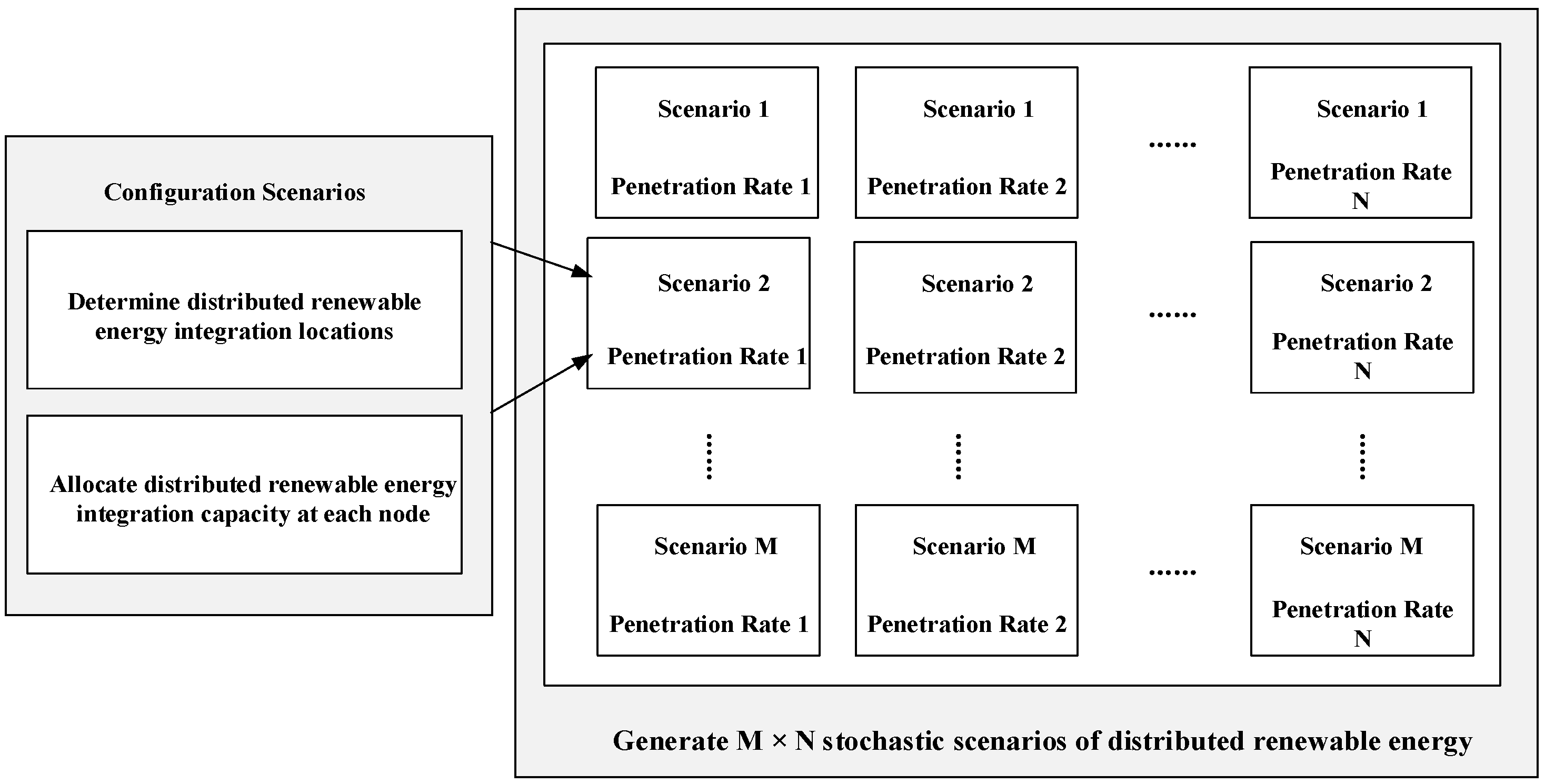
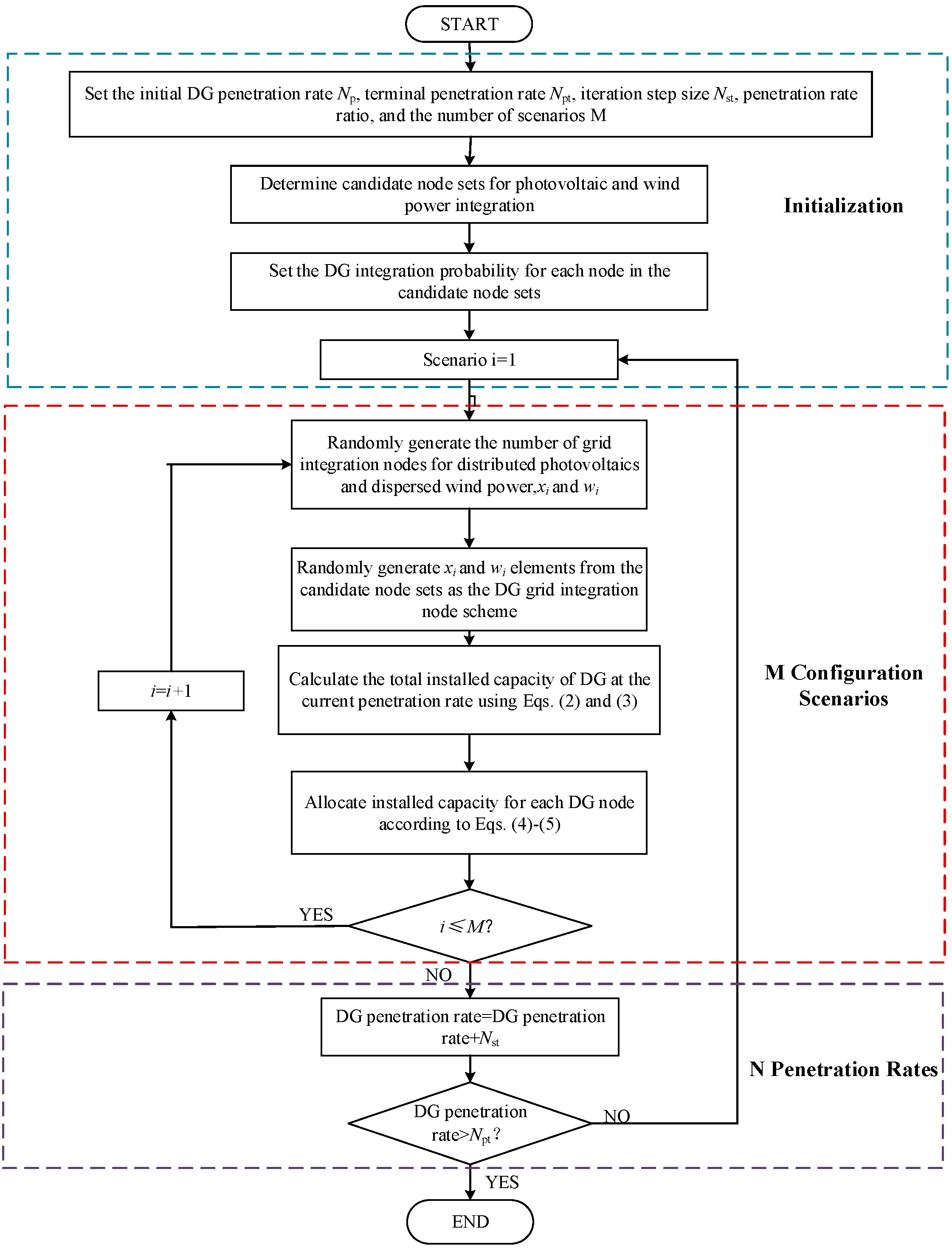
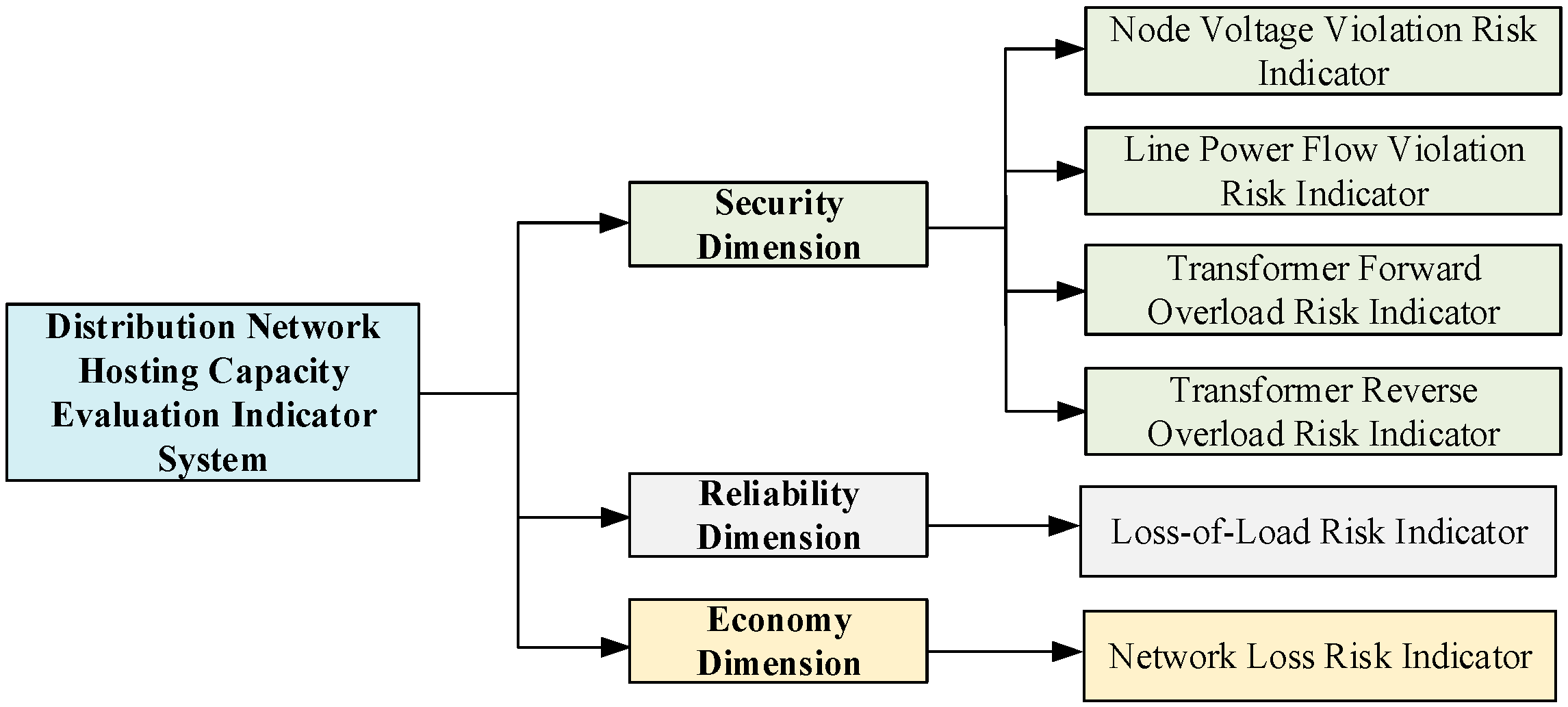
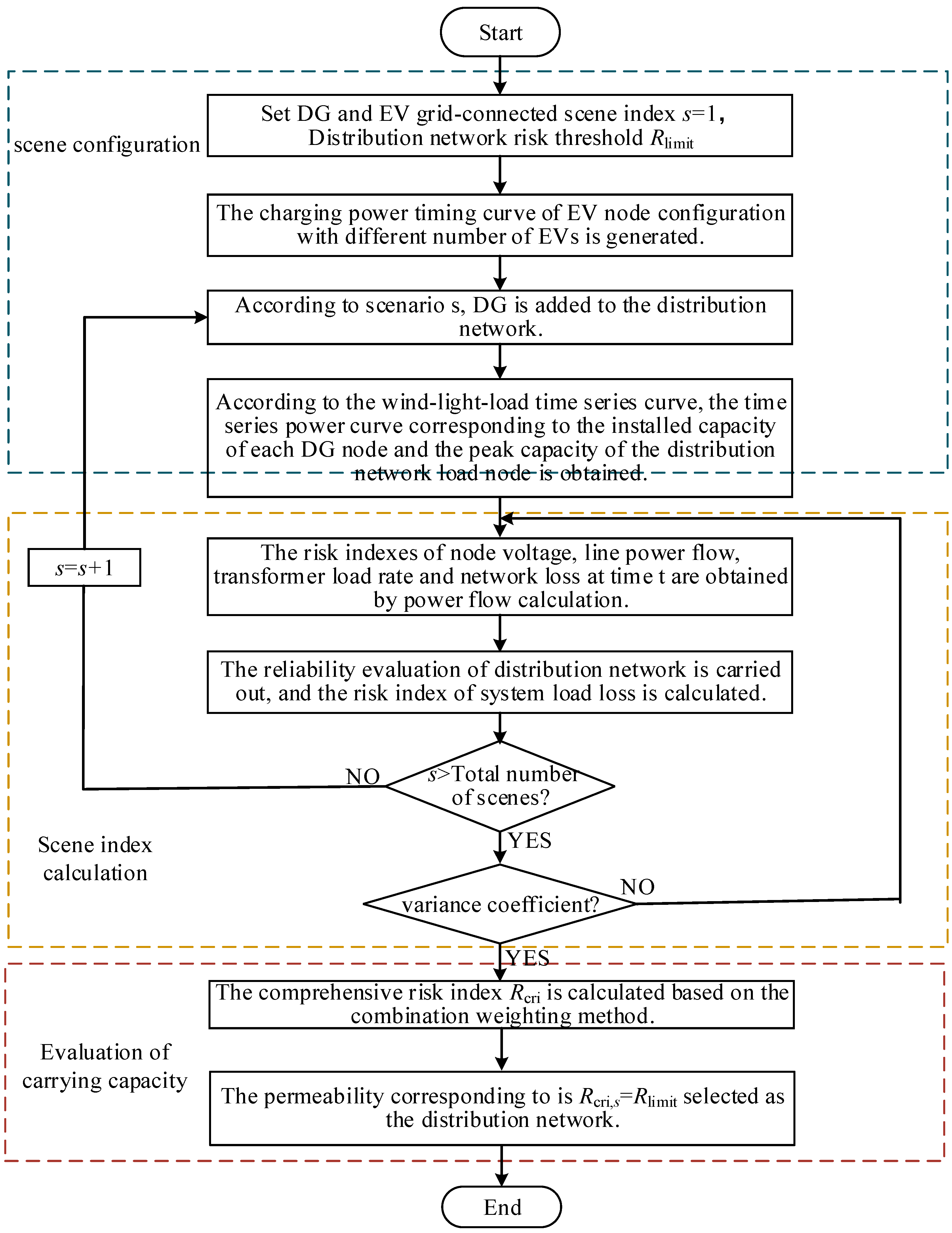


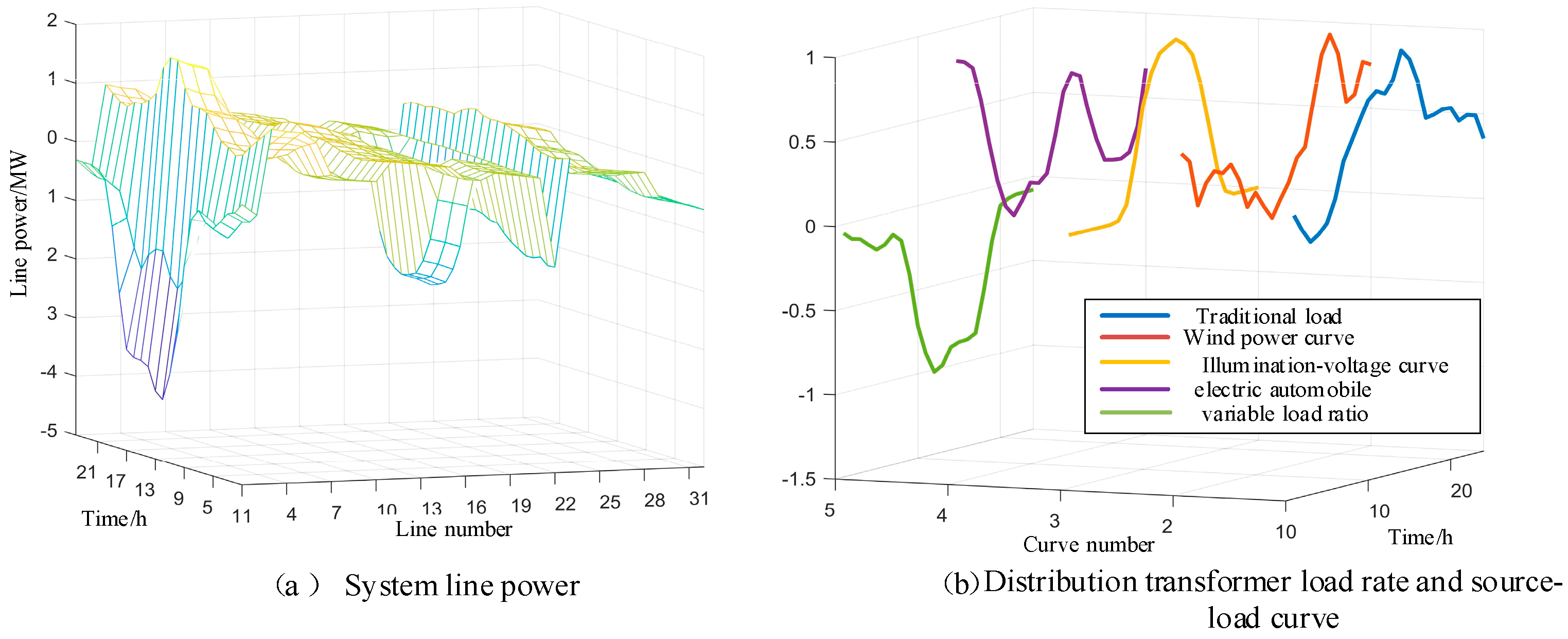
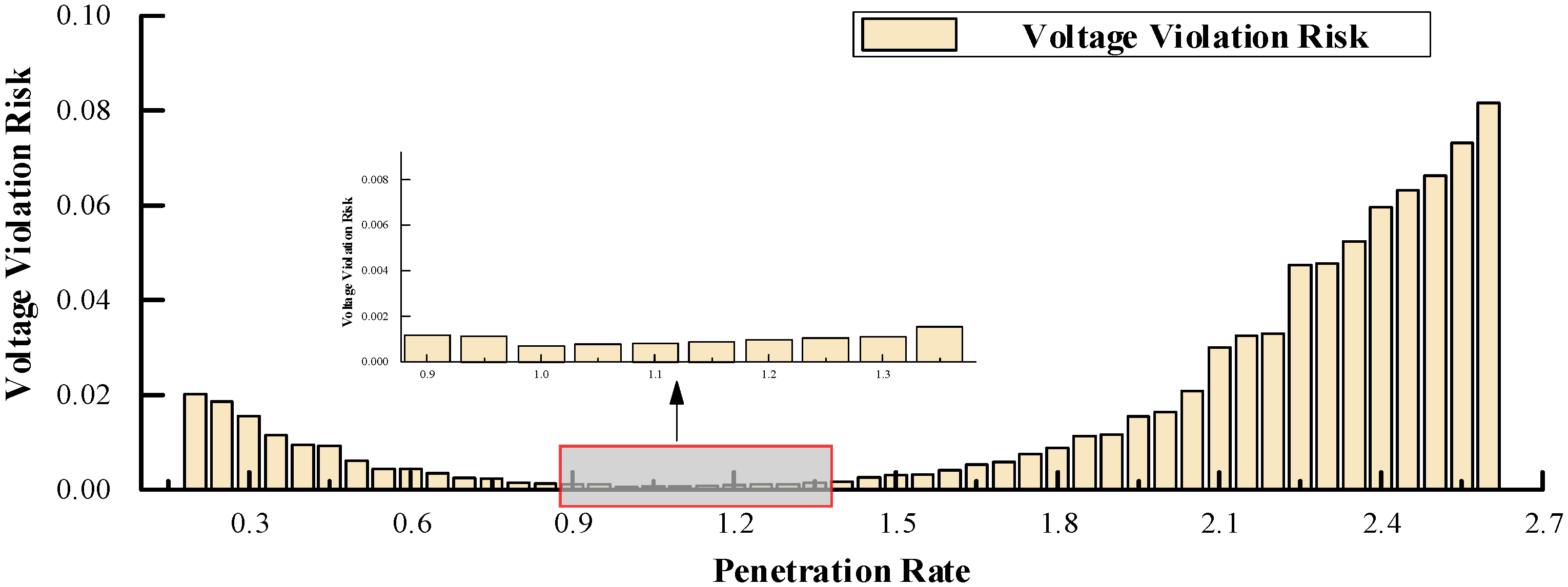
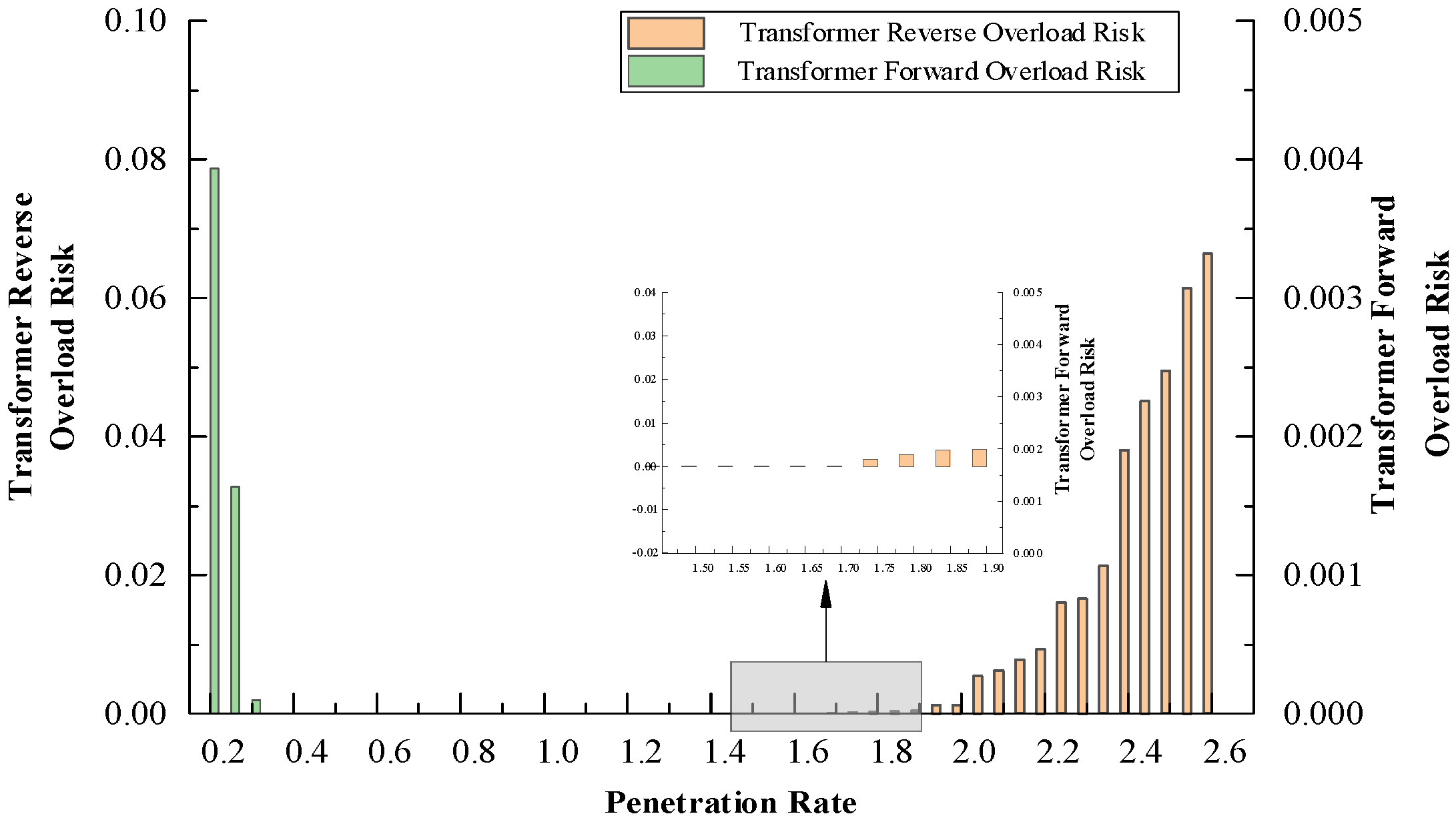
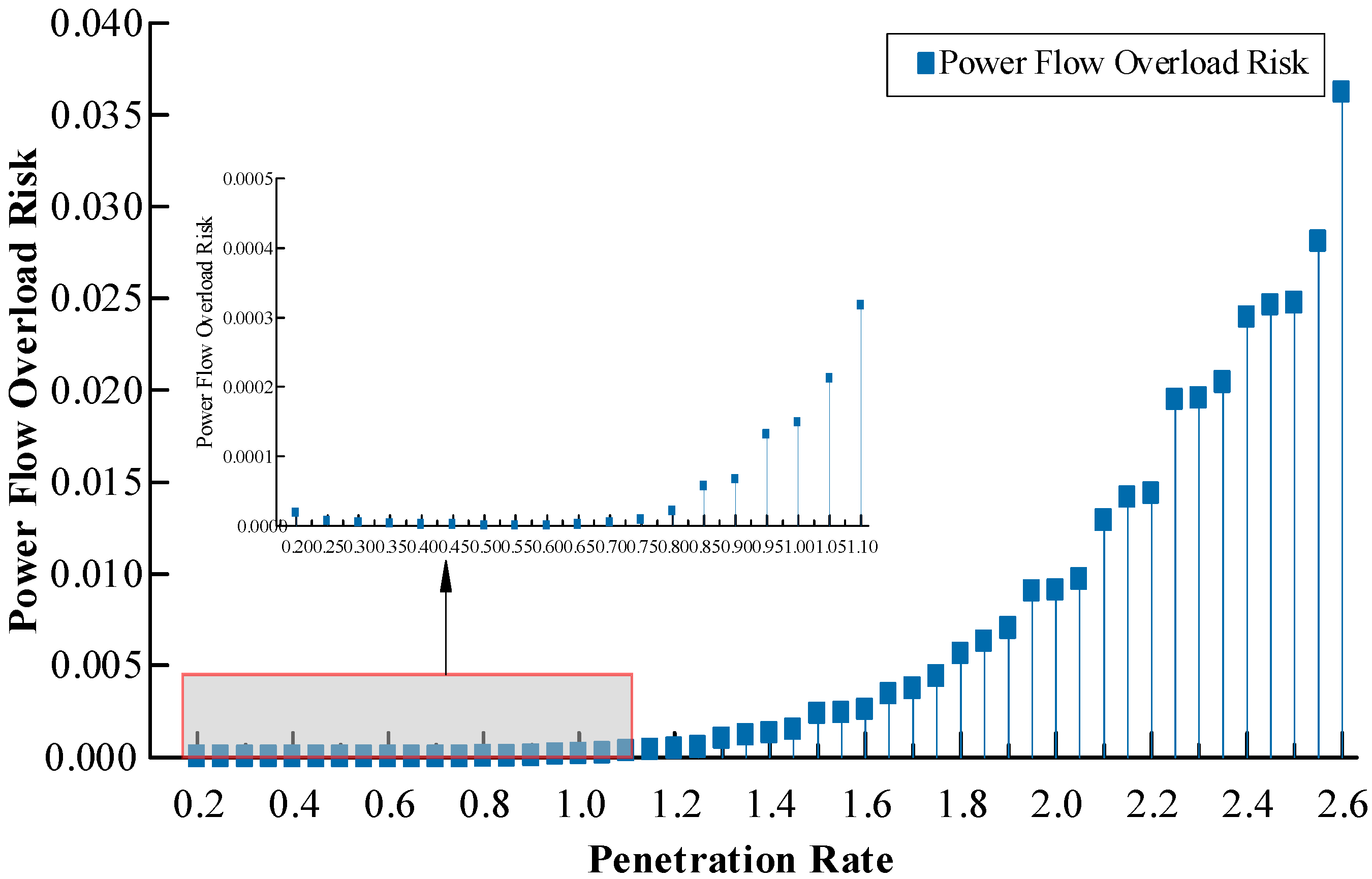

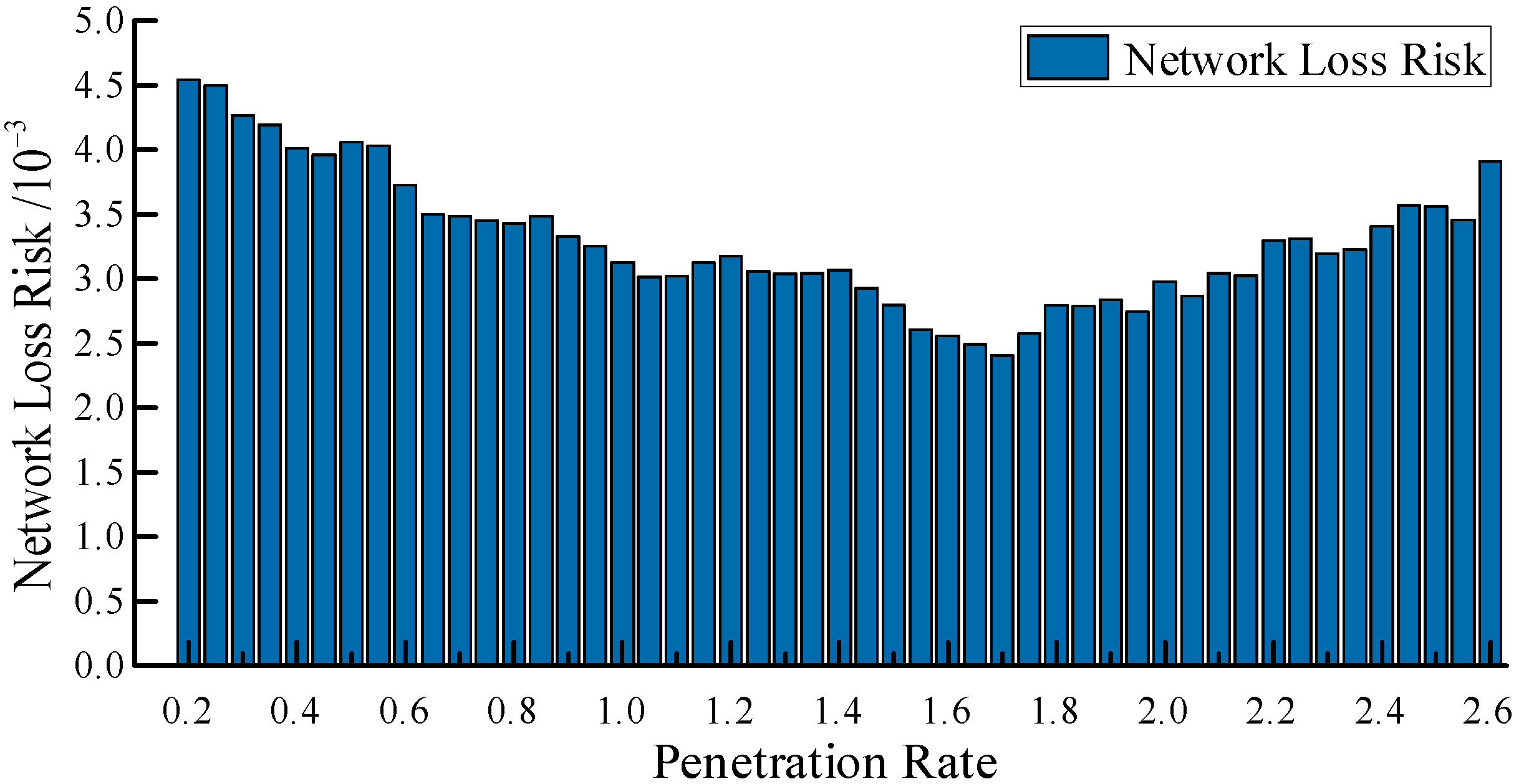

| Penetration Level | Risk Value | ||||
|---|---|---|---|---|---|
| Voltage Violation | Power Flow Violation | Forward Overload | Loss-of-Load Risk | Network Loss Risk | |
| 20% | 2.025 × 10−2 | 1.749 × 10−5 | 3.937 × 10−3 | 9.714 × 10−5 | 4.55 × 10−3 |
| 25% | 1.861 × 10−2 | 5.854 × 10−6 | 1.638 × 10−3 | 9.591 × 10−5 | 4.49 × 10−3 |
| 30% | 1.549 × 10−2 | 4.041 × 10−6 | 9.909 × 10−5 | 9.331 × 10−5 | 4.27 × 10−3 |
| 35% | 1.149 × 10−2 | 2.541 × 10−6 | 0 | 9.251 × 10−5 | 4.19 × 10−3 |
| 40% | 9.255 × 10−3 | 3.323 × 10−7 | 0 | 9.246 × 10−5 | 4.01 × 10−3 |
| Penetration Level (%) | DG Hosting Capacity (MW) | Composite Risk Indicator | Description |
|---|---|---|---|
| 100 | 3.715 | 5.268 × 10−2 | Minimum system security risk (security-only assessment) |
| 105 | 3.900 | 5.159 × 10−2 | Optimal hosting capacity considering multi-dimensional risks |
| 140 | 5.201 | 6.592 × 10−2 | Maximum hosting capacity under acceptable risk threshold |
| >140 | >5.201 | >6.592 × 10−2 | Risk increases nonlinearly beyond acceptable limits |
Disclaimer/Publisher’s Note: The statements, opinions and data contained in all publications are solely those of the individual author(s) and contributor(s) and not of MDPI and/or the editor(s). MDPI and/or the editor(s) disclaim responsibility for any injury to people or property resulting from any ideas, methods, instructions or products referred to in the content. |
© 2025 by the authors. Licensee MDPI, Basel, Switzerland. This article is an open access article distributed under the terms and conditions of the Creative Commons Attribution (CC BY) license (https://creativecommons.org/licenses/by/4.0/).
Share and Cite
Liu, H.; He, J.; Deng, L.; Xu, J.; Chen, Y. Assessment of Distribution Network Hosting Capacity Incorporating Multiple Uncertainty Factors. Electronics 2025, 14, 4495. https://doi.org/10.3390/electronics14224495
Liu H, He J, Deng L, Xu J, Chen Y. Assessment of Distribution Network Hosting Capacity Incorporating Multiple Uncertainty Factors. Electronics. 2025; 14(22):4495. https://doi.org/10.3390/electronics14224495
Chicago/Turabian StyleLiu, Haitao, Jinxiong He, Liuyi Deng, Jianyuan Xu, and Yikai Chen. 2025. "Assessment of Distribution Network Hosting Capacity Incorporating Multiple Uncertainty Factors" Electronics 14, no. 22: 4495. https://doi.org/10.3390/electronics14224495
APA StyleLiu, H., He, J., Deng, L., Xu, J., & Chen, Y. (2025). Assessment of Distribution Network Hosting Capacity Incorporating Multiple Uncertainty Factors. Electronics, 14(22), 4495. https://doi.org/10.3390/electronics14224495





